General, Sir John Monash, Personal Files Book 21, 10 September - 3 October 1918 - Part 1
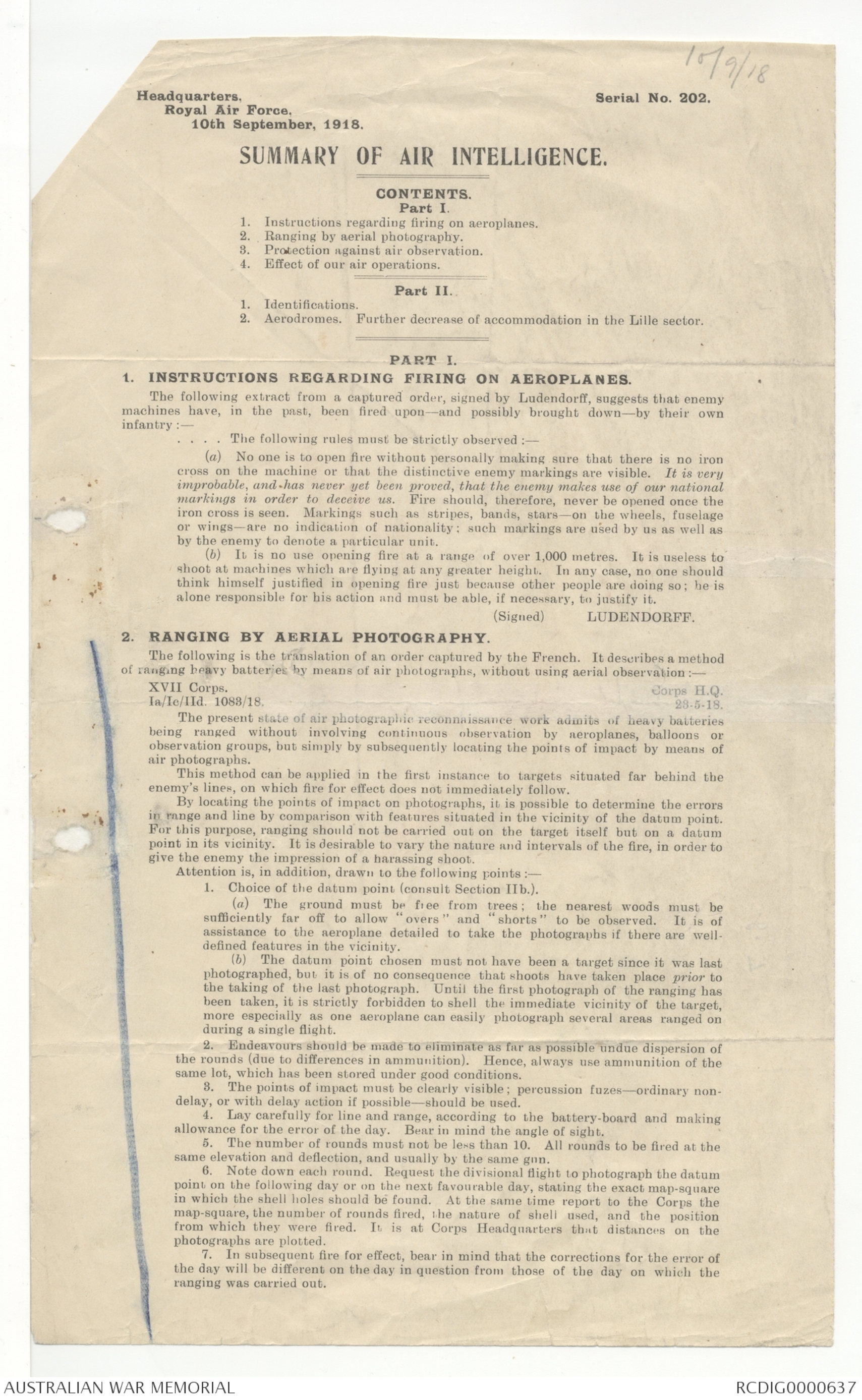
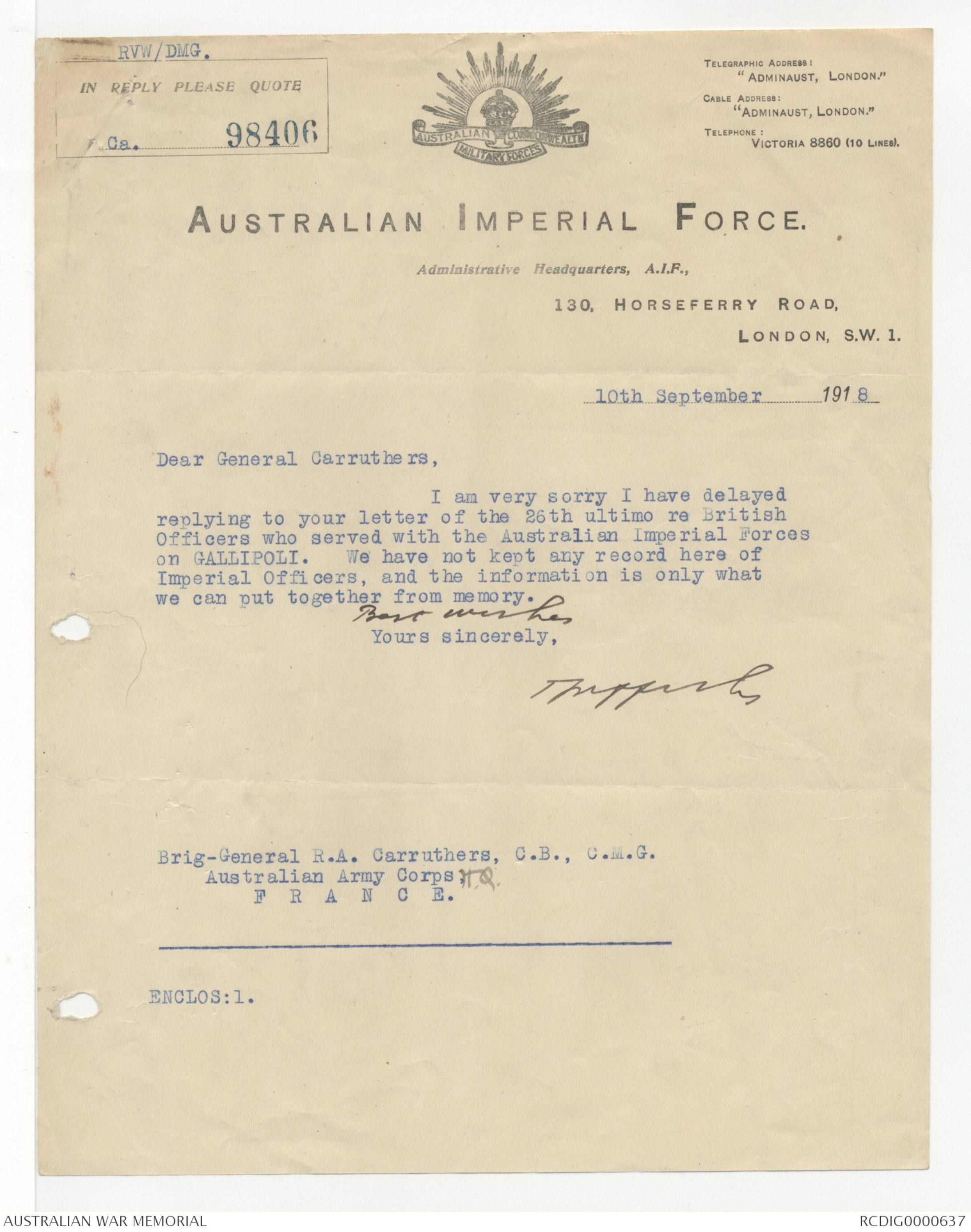
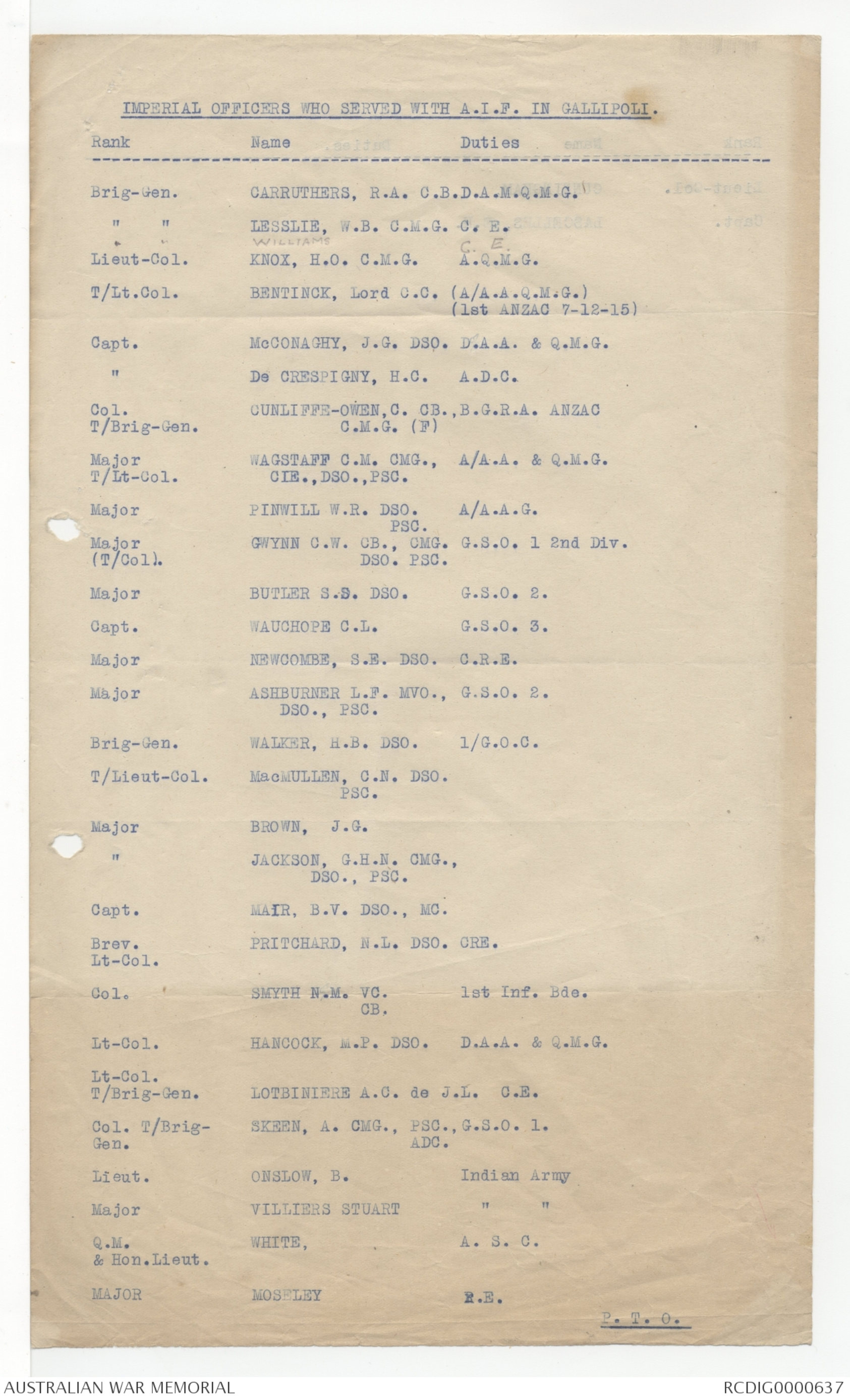
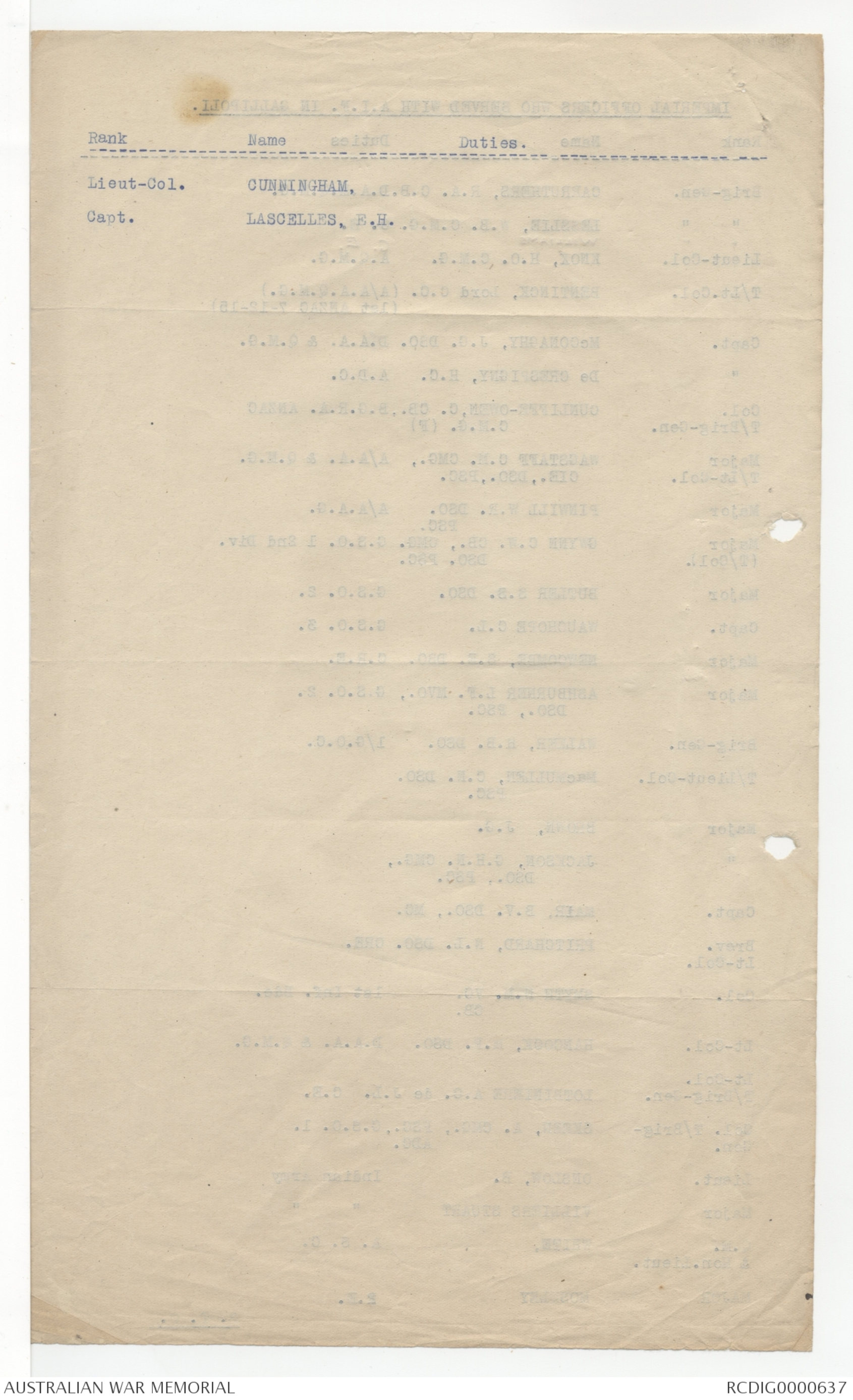
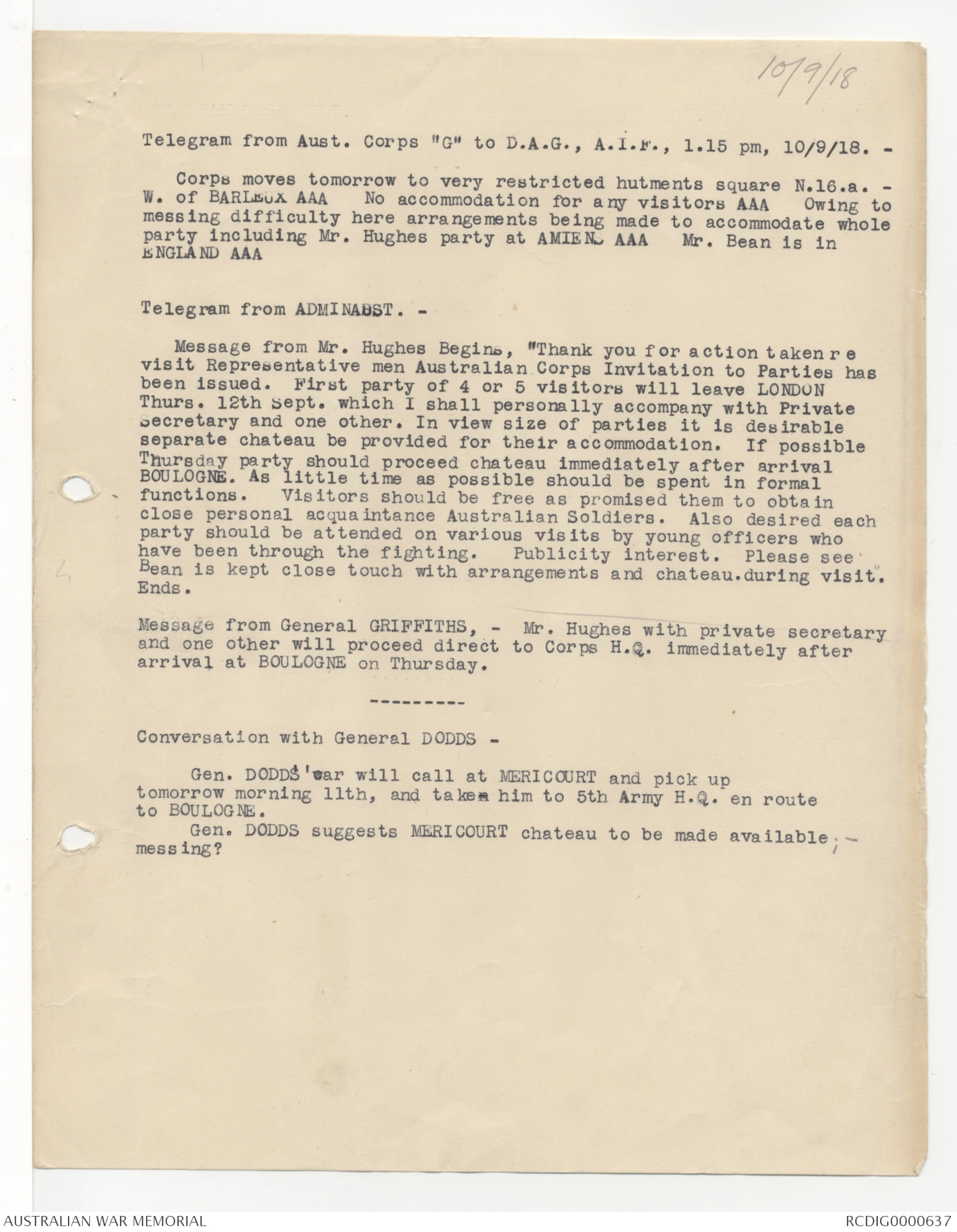
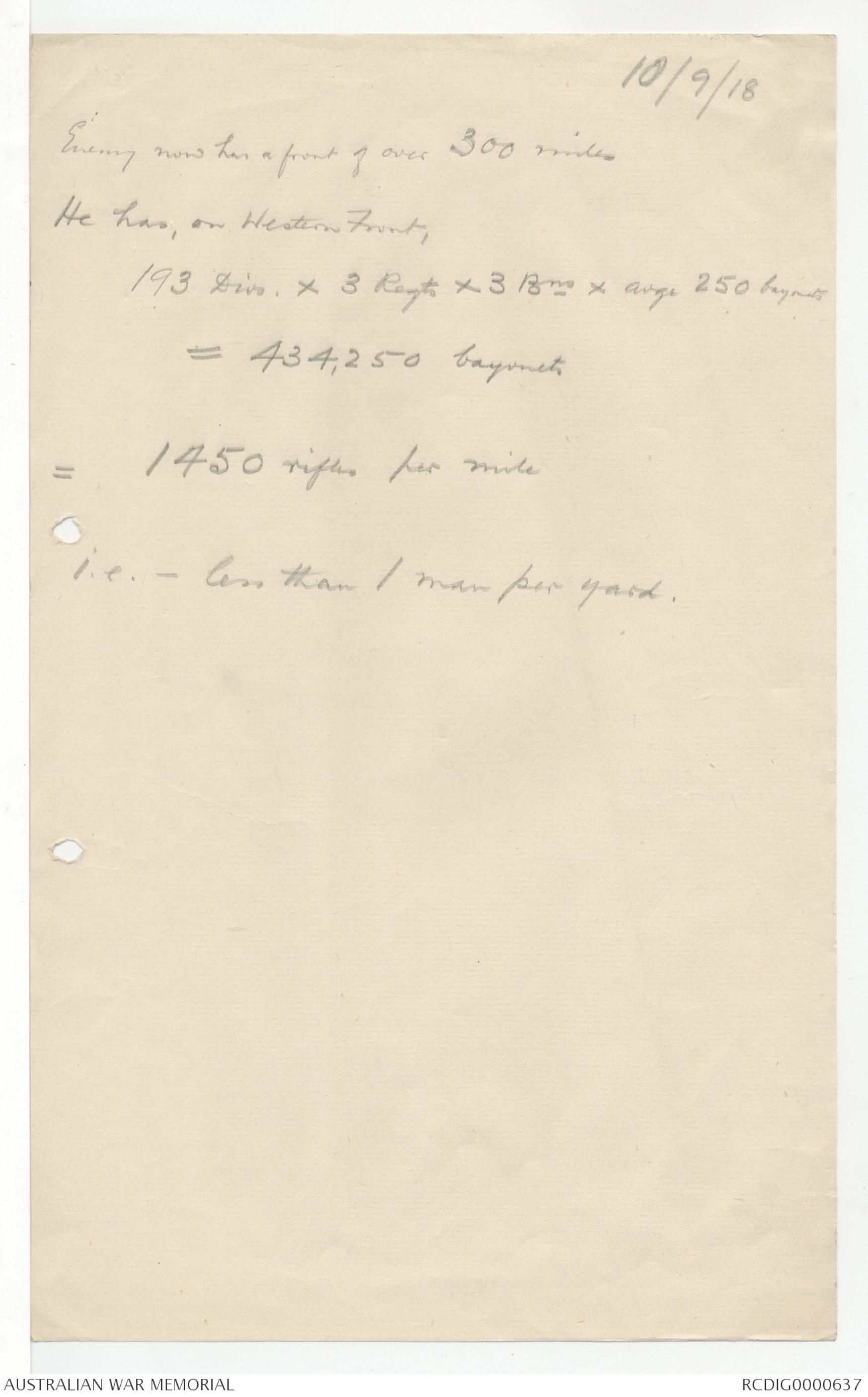
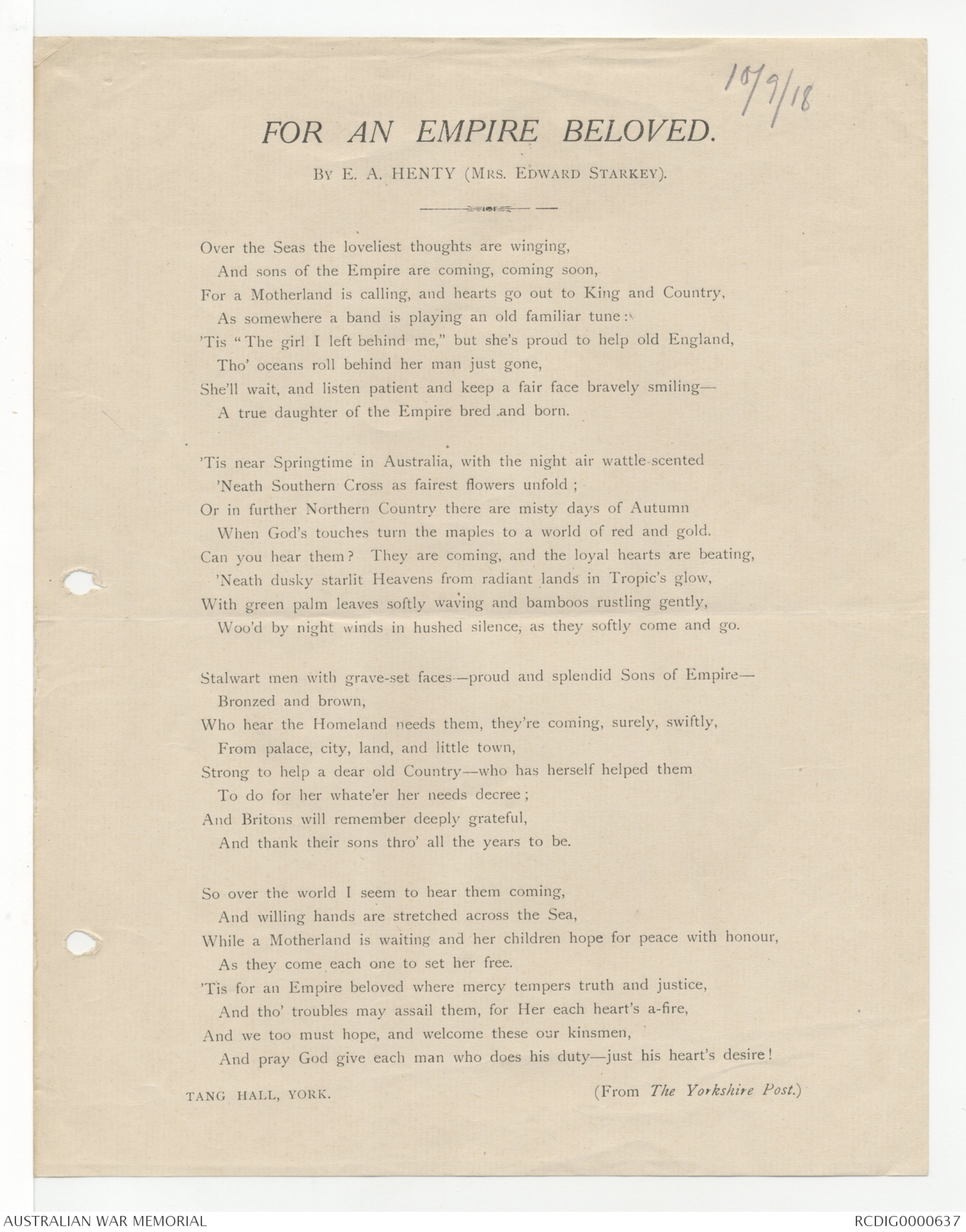
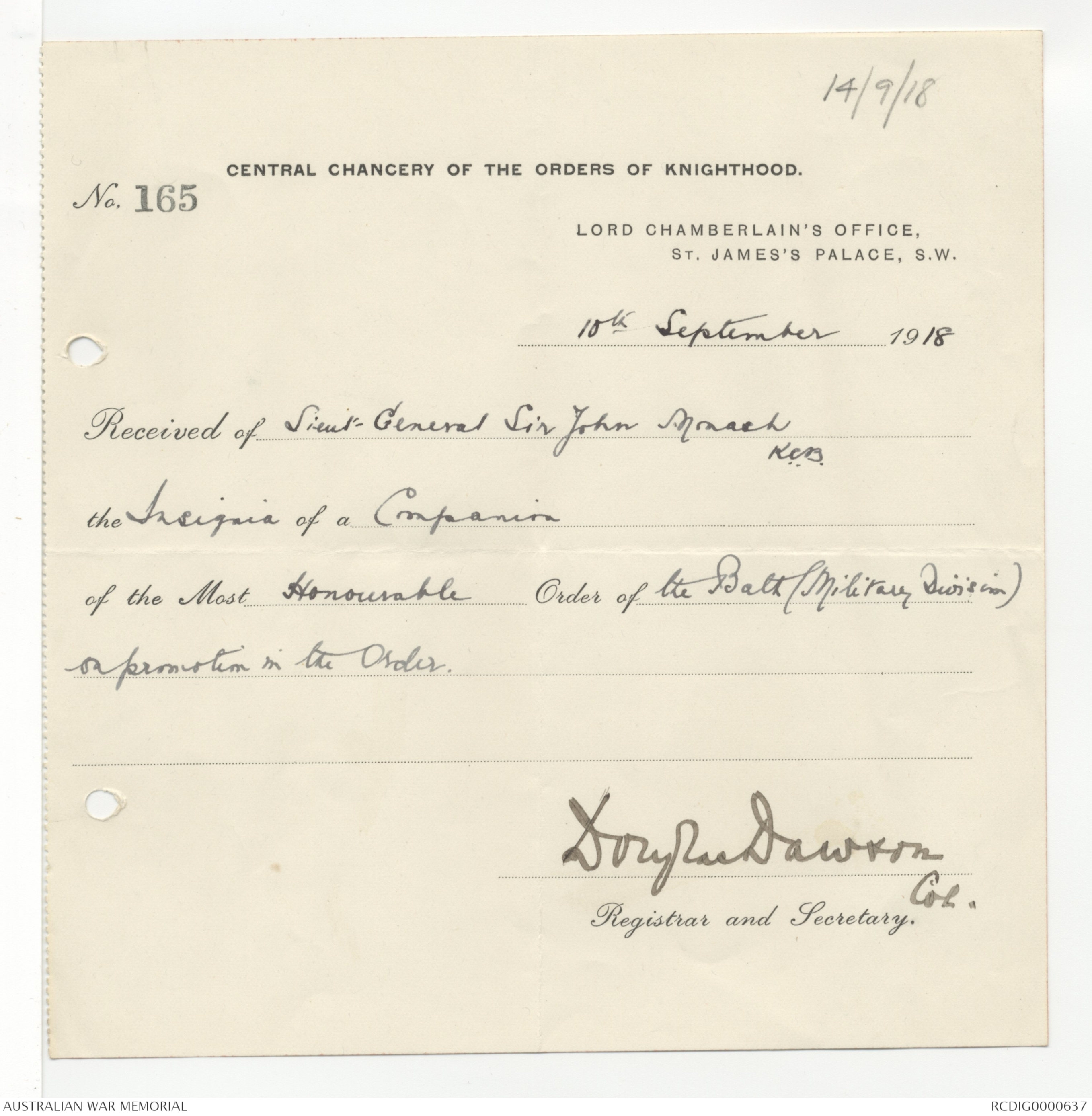
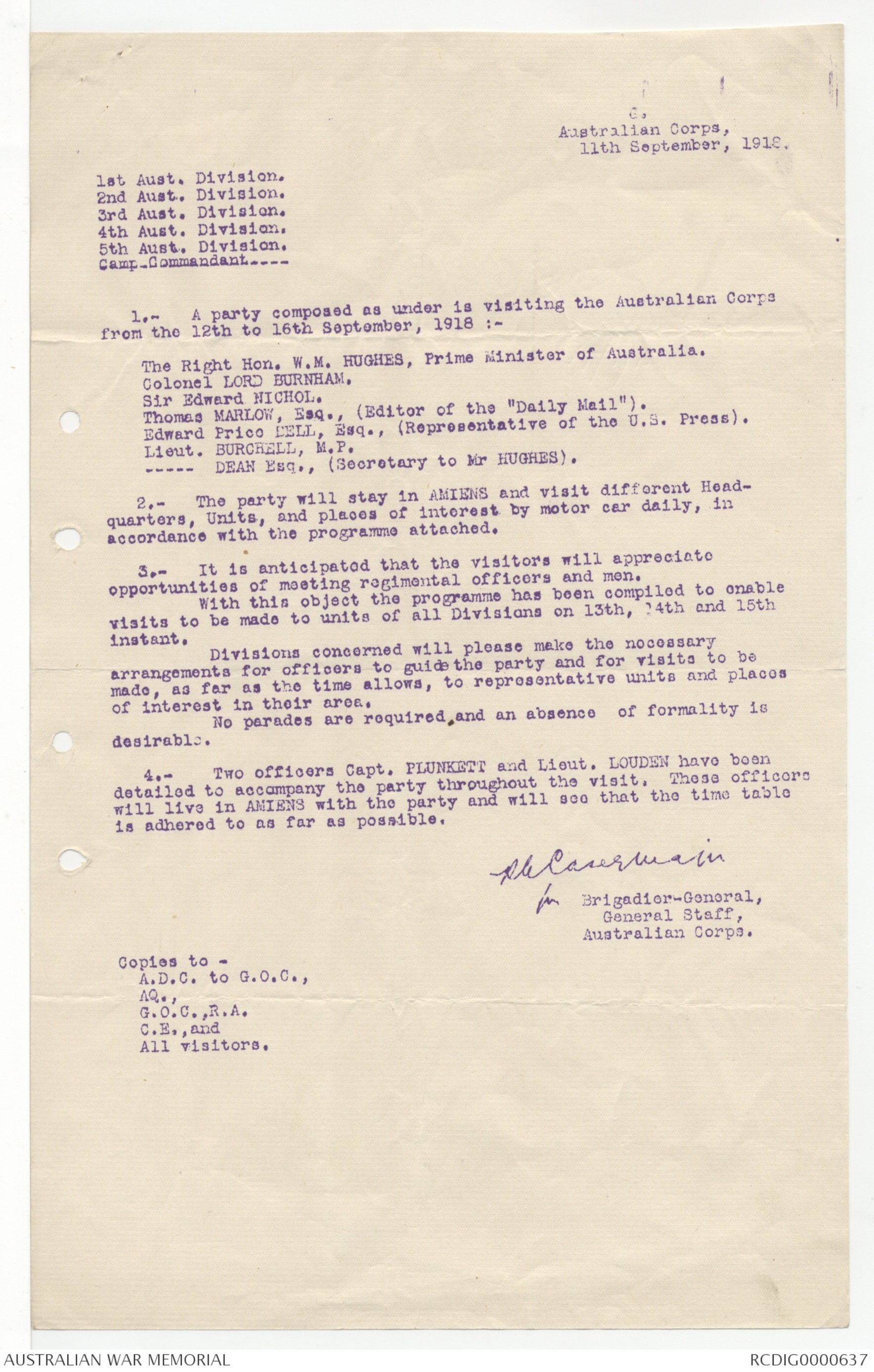
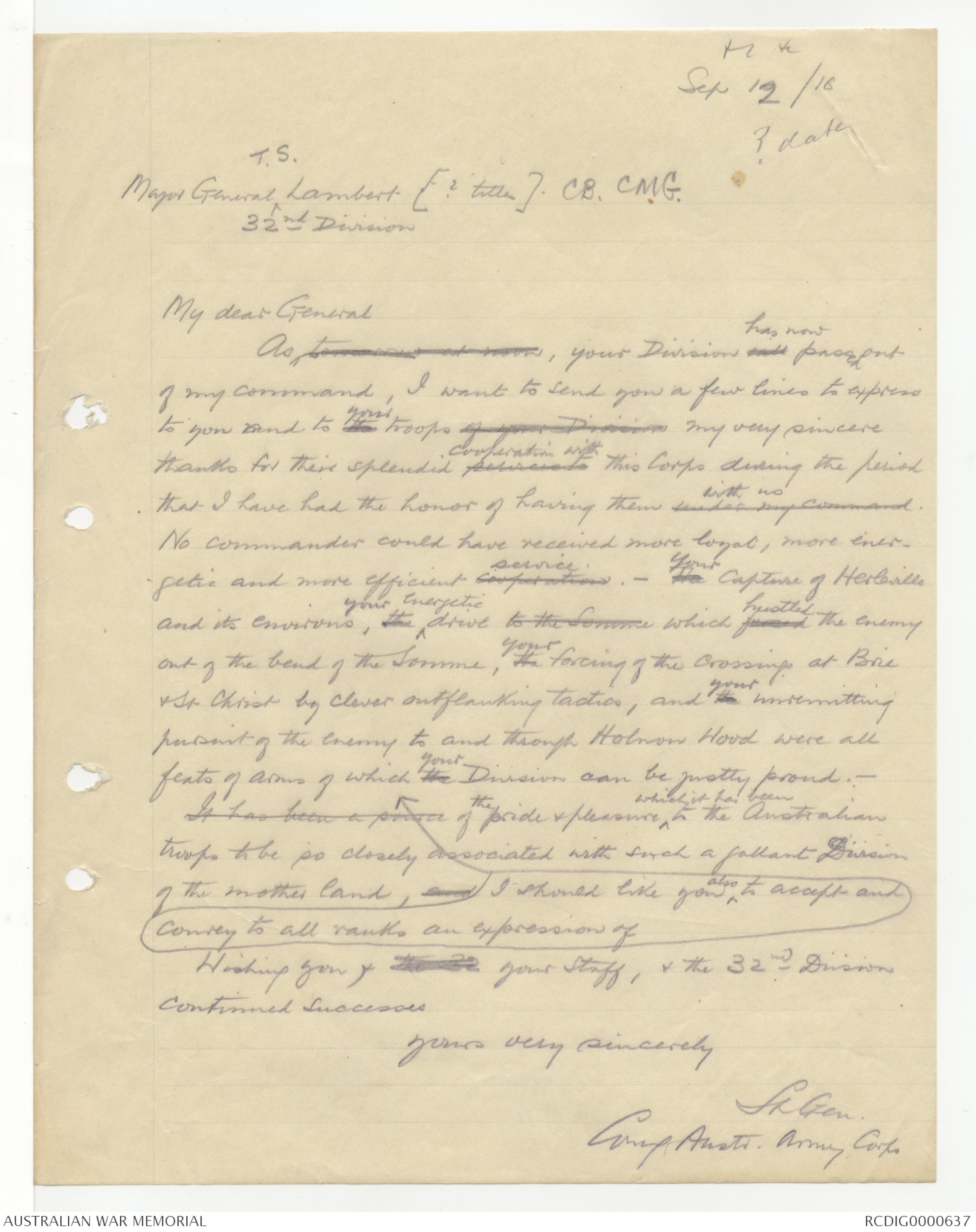
[*15/9/18*]
Serial No. 202.
Headquarters.
Royal Air Force.
1Oth September, 1818.
SUMMARY OF AIR INTELLIGENCE.
CONTENTS.
Part I.
1. Instructions regarding firing on aeroplanes.
2. Ranging by aerial photography.
8. Protection against air observation.
4. Erfect of our air operations.
Part II.
1. Identifications.
2. Aerodromes. Further decrease of accommodation in the Lille sector.
PART I
1. INSTRUCTIONS REGARDING FIRING ON AEROPLANES.
The following extract from a captured order, signed by Ludendorff, suggests that enemy
machines have, in the past, been fired upon—and possibly brought down— by their own
infantry:
The following rules must be strictly observed:-
(c) No one is to open fire without personally making sure that there is no iron
cross on the machine or that the distinctive enemy markings are visible. It is very
improbable, and. has never yet been proved, that the enemy makes use of our national
markings in order to deceive us. Fire should, therefore, never be opened once the
iron cross is seen. Markings such as stripes, bands, stars–on the wheels, fuselage
or wings– are no indication of nationality; such markings are used by us as well as
by the enemy to denote a particular unit.
(b) It is no use opening fire at a range of over 1,000 metres. It is useless to
shoot at machines which are flying at any greater height. In any case, no one should
think himself justified in opening fire just because other people are doing so; he is
alone responsible for his action and must be able, if necessary, to justify it.
(Signed) LUDENDORFF.
2. RANGING BY AERLAL PHOTOGRAPHY.
The following is the translation of an order captured by the French. It describes a method
of ranging heavy batteries by means of air photographs, without using aerial observation: -
XVII Corps.
Ia/Ie/IId. 1088 18.
Corps H.Q.
28-5-18
The present state of air photographic reconnaissance work admits of heavy batteries
being ranged without involving continuous observation by aeroplanes, balloons or
observation groups, but simply by subsequently locating the points of impact by means of
air photographs.
This method can be applied in the first instance to targets situated far behind the
enemy's lines, on which fire for effect does not immediately follow.
By locating the points of impact on photographs, it is possible to determine the errors
in range and line by comparison with features situated in the vicinity of the datum point.
For this purpose, ranging should not be carried out on the target itself but on a datum
point in its vicinity. It is desirable to vary the nature and intervals of the fire, in order to
give the enemy the impression of a harassing shoot.
Attention is, in addition, draw, to the following points:-
1. Choice of the datum point (consult Section IIb.).
(a) The ground must be free from trees; the nearest woods must be
sufficiently far off to allow "overs" and "shorts" to be observed. It is of
assistance to the aeroplane detailed to take the photographs if there are well
defined features in the vicinity.
(b) The datum point chosen must not have been a target since it was last
photographed, but it is of no consequence that shoots have taken place prior to
the taking of the last photograph. Until the first photograph of the ranging has
been taken, it is strictly forbidden to shell the immediate vicinity of the target,
more especially as one aeroplane can easily photograph several areas ranged on
during a single flight.
2. Endeavours should be made to eliminate as far as possible undue dispersion of
the rounds (due to differences in ammunition). Hence, always use ammunition of the
same lot, which has been stored under good conditions.
3. The points of impact must be clearly visible; percussion fuzes- ordinary nondelay,
or with delay action if possible-should be used.
4. Lay carefully for line and range, according to the battery board and making
allowance for the error of the day. Bear in mind the angle of sight.
5. The number of rounds must not be less than 10. All rounds to be fired at the
same elevation and deflection, and usually by the same gun.
6. Note down each round. Request the divisional night to photograph the datum
point on the following day or on the next favourable day, stating the exact map-square
in which the shell holes should be found. At the same time report to the Corps the
map-square, the number of rounds fired, the nature of shell used, and the position
from which they were fired. It is at Corps Headquarters that distances on the
photographs are plotted.
7. In subsequent fire (or effect, bear in mind that the corrections for the error of
the day will be different on the day in question from those of the day on which the
ranging was carried out.
RVW/DMG.
I REPLY PLEASE QUOTE
Ca. 98406
TELEGRAPHIC ADDRESS:
"ADMINAUST, LONDON."
CABLE ADDRESS:
"ADMINAUST, LONDON."
TELEPNONE:
VICTORIA 8860 (10 LINES).
AUSTRALIAN IMPERIAL FORCE
Administrative Headquarters, A.IF.,
130. HORSEFERRY ROAD,
LONDON S.W. 1.
10th September 1918
Dear General Carruthers,
I am very sorry I have delayed
replying to your letter of the 26th ultimo re British
Officers who served with the Australian Imperial Forces
on GALLIPOLI. We have not kept any record here of
Imperial Officers, and the information is only what
we can put together from memory.
Best Wishes
Yours sincerely,
Ingo
Brig-General R. A. Carruthers, C.B., C.M.G.
Australian Army Corps, .
FRANCE.
ENCLOS:1.
IMPERIAL OFFICERS WHO SERVED WITH A.I.F. IN GALLIPOLI.
| Rank | Name | Duties |
| Brig-Gen. | CARRUTHERS, R. A. C.B. | D.A.M.Q.M.G. |
| “ “ | LESSLIE, W. B. C.M.G. | C. E. |
| “ “ | WILLIAMS | C. E. |
| Lieut-Col. | KNOW, H.O. C.M.G. | A.Q.M.G. |
| T/Lt.Col. | BENTICK, Lord C. C. | (A/A.A.Q.M.G.) (1st ANZAC 7-12-15) |
| Capt. | McCONAGHY, J, G, DSO. | D.A.A. & Q.M.G. |
| “ | De CRESPIGNY, H. C. | A.D.C. |
| Col. T/Brig-Gen. |
CUNIFFE-OWEN, C. CB., C.M.G. (F) |
B.G.R.A. ANZAC |
| Major T/Lt-Col. |
WAGSTAFF C. M. CMG., CIE., DSO., PSC. |
A/A.A. &Q.M.G. |
| Major | PINWILL W. R. DSO. PSC. |
A/A.A.G. |
| Major (T/Col.) |
GWYNN C. W. CB., CMG. DSOO. PSC. |
G.S.O.1 2nd DIV. |
| Major | BUTLER S. S. DSO. | G.S.O. 2. |
| Capt. | WACHOPE C. L. | G.S.O. 3. |
| Major | NEWCOMBE, S. E. DSP. | C.R.E. |
| Major | ASHBURNER L. F. MVO., DSO., PSC. |
G.S.O. 2. |
| Brig-Gen. | WALKER, H. B. DSO. | 1/G.O.C. |
| T/Lieut-Col. | MacMULLEN, C. N. DSO. PSC. |
|
| Major | BROWN, J. G. | |
| “ | JACKSON G. H. N. CMG. DSO., PSC. |
|
| Capt. | MAIR, B. V. DSO., MC. | |
| Brev. Lt-Col. |
PRITCHARD, N. L. DSO. | CRE. |
| Col. | SMYTH N. M. VC. CB. |
1st Inf. Bde. |
| Lt-Col. | HANCOCK, M. P. DSO. | D.A.A. & Q.M.G. |
| Lt-Col. T/Brig-Gen. |
LOTBINIERE, A. C. de J. L. | C.E. |
| Col. T/Brig-Gen. | SKEEN, A. CMG., PSC., ADC. |
G.S.O. 1. |
| Lieut. | ONSLOW, B. | Indian Army |
| Major | VILLIERS STUART | “ “ |
| Q.M. & Hon.Lieut. |
WHITE, | A.S.C. |
| MAJOR | MORSELEY | R.E. |
P.T.O.
| Rank | Name | Duties |
| Lieut-Col. | CUNNINGHAM, | |
| Capt. | LASCELLES, E. H. |
[*10/9/18*]
Telegram from Aust. Corps "G" to D.A.G., A.I.F., 1.15 pm, 10/9/18. -
Corps moves tomorrow to very restricted hutments square N.16.a. -
W. of BARLEUX AAA No accommodation for any visitors AAA Owing to
messing difficulty here arrangements being made to accommodate whole
party including Mr. Hughes party at AMIEN AAA Mr. Bean is in
ENGLAND AAA
Telegram from ADMINASST. -
Message from Mr. Hughes Begins, "Thank you for action taken re
visit Representative men Australian Corps Invitation to Parties has
been issued. First party of 4 or 5 visitors will leave LONDON
Thurs. 12th sept. which I shall personally accompany with Private
Secretary and one other. In view size of parties it is desirable
separate chateau be provided for their accommodation. If possible
Thursday party should proceed chateau immediately after arrival
BOULOGNE. As little time as possible should be spent in formal
functions. Visitors should be free as promised them to obtain
close personal acquaintance Australian Soldiers. Also desired each
party should be attended on various visits by young officers who
have been through the fighting. Publicity interest. Please see
Bean is kept close touch with arrangements and chateau.during visit.
Ends.
Message from General GRIFFITHS, - Mr. Hughes with private secretary
and one other will proceed direct to Corps H.Q. immediately after
arrival at BOULOGNE on Thursday.
Conversation with General DODDS -
Gen. DODDS'war will call at MERICOURT and pick up
tomorrow morning 11th, and take him to 5th Army H.Q. en route
to BOULOGNE.
Gen. DODDS suggests MERICOURT chateau to be made available; -
messing?
10/9/18
Enemy now has a front of over 300 miles
He has on Western Front,
193 Divs. x 3 Regts 3 3 Bns x avge 250 bayonets
= 434,250 bayonets
= 1450 rifles per mile
i.e. - less than 1 man per yard.
[*18/9/18*]
FOR AN EMPIRE BELOVED.
BY E. A. HENTY (MRS EDWARD STARKEY)
Over the Seas the loveliest thoughts are winging,
And sons of the Empire are coming, coming soon,
For a Motherland is calling, and hearts go out to King and Country,
As somewhere a band is playing an old familiar tune:
'Tis "The girl I left behind me," but she's proud to help old England,
Tho' oceans roll behind her man just gone,
She'll wait, and listen patient and keep a fair face bravely smiling-
A true daughter of the Empire bred and born.
''Tis near Springtime in Australia, with the night air wattle scented
Neath Southern Cross as fairest flowers unfold ;
Or in further Northern Country there are misty days of Autumn
When God's touches turn the maples to a world of red and gold.
Can you hear them? They are coming, and the loyal hearts are beating,
'Neath dusky starlit Heavens from radiant lands in Tropic's glow,
With green palm leaves softly waving and bamboos rustling gently,
Wood by night winds in hushed silence, as they softly come and go.
Stalwart men with grave-set faces—proud and splendid Sons of Empire-
Bronzed and brown,
Who hear the Homeland needs them, theyre coming, surely, swiftly,
From palace, city, land, and lttle town,
Strong to help a dear old Country—who has herself helped them
To do for her whate'er her needs decree ;
And Britons will remember deeply grateful,
And thank their sons thro' al the years to be.
So over the world I seem to hear them coming,
And willing hands are stretched across the Sea,
While a Motherland is waiting and her children hope for peace with honour,
As they come each one to set her free
'Tis for an Empire beloved where mercy tempers truth and justice,
And tho' troubles may assail them, for Her each heart's a-fire,
And we too must hope, and welcome these our kinsmen,
And pray God give each man who does his duty-just his hearts desire!
(From The Yorkshire Post)
TANG HALL, YORK.
[*14/9/18*]
CENTRAL CHANCERY OF THE ORDERS OF KNIGHTHOOD.
No. 165
LORD CHAMBERLAIN'S OFFICE,
ST. JAMES'S PALACE, S.W.
10th September 1918
Received of Lient- General Sir John Monash
K.C.B.
the Insignia of a Companion
of the Most Honourable Order of the Bath (Military Division)
on promotion in the Order,
Douglas Dawson
Col.
Registrar and Secretary.
6.
Australian Corps,
11th September, 1918.
lst Aust. Division.
2nd Aust. Division.
3rd Aust. Division.
4th Aust. Division.
5th Aust. Division.
Camp-Commandant.
1.- A party composed as under is visiting the Australian Corps
from the 12th to 16th Septomber, 1918 :-
The Right Hon. W. M. HUGHES, Prime Minister of Australia.
Colonel LORD BURNHAM.
Sir Edward NICHOL.
Thomas MARLOW, Esq., (Editor of the "Daily Mail").
Edward Prico BELL, Esq., (Representative of the U.S. Press).
Lieut. BURCHELL, M.P.
DEAN Esq., (Secretary to Mr HUGHES).
2.- The party will stay in AMIENS and visit different Headquarters,
Units, and places of interest by motor car daily, in
accordance with the programme attached.
3.- It is anticipated that the visitors will appreciate
opportunities of meeting regimental officers and men.
With this object the programme has been compiled to enable
visits to be made to units of all Divisions on 13th, 14th and 15th
instant.
Divisions concerned will please make the necessary
arrangements for officers to guide the party and for visits to be
made, as far as the time allows, to representative units and places
of interest in their area.
No parades are required, and an absence of formality is
desirable.
4.- Two officers Capt. PLUNKETT and Lieut. LOUDEN have been
detailed to accompany the party throughout the visit. These officers
will live in AMIENS with the party and will see that the time table
is adhered to as far as possible.
P [[?]] Case[[?]]
for Brigadier-General,
General Staff,
Australian Corps.
Copies to -
A.D.C. to G.0.C.,
AQ.,
G.O.C., R.A.
C.E., and
All visitors.
[[?]]
Sep 12/18
? date
Major General ^T. S. Lambert [?tillen]. CB. CMG.
32nd Division
My dear General
As, tomorrow at noon, your Division will ^has now passed out
of my command, I want to send you a few lines to express
to you nand the your troops of your Division my very Sincere
thanks for their splendid [[p?]] to cooperation with this Corps during the period
that I have had the honor of having them under my command with us.
No commander could have received more loyal, more energetic
and more efficient cooperation service. - The Your capture of Herleville
and its environs, the ^your energetic, drive to the Somme which forced hustled the enemy
out of the bend of the Somme, the your forcing of the crossing at Brie
& St Christ by clever outflanking tactics, and the your unremitting
pursuit of the enemy to and through Holnun Wood were all
feats of arms of which the your Division can be justly proud.-It has been a source of pride ^I should like you ^also to accept and convey to all ranks an expression of the pride & pleasure ^which it has been to the Australian
troops to be so closely associated with such a gallant Division
of the mother land, and
Wishing you & the 32 your staff, & the 32nd Division
continued successes
Your very sincerely
Lt Gen.
Comg Aust. Army Corps
 Sam scott
Sam scottThis transcription item is now locked to you for editing. To release the lock either Save your changes or Cancel.
This lock will be automatically released after 60 minutes of inactivity.